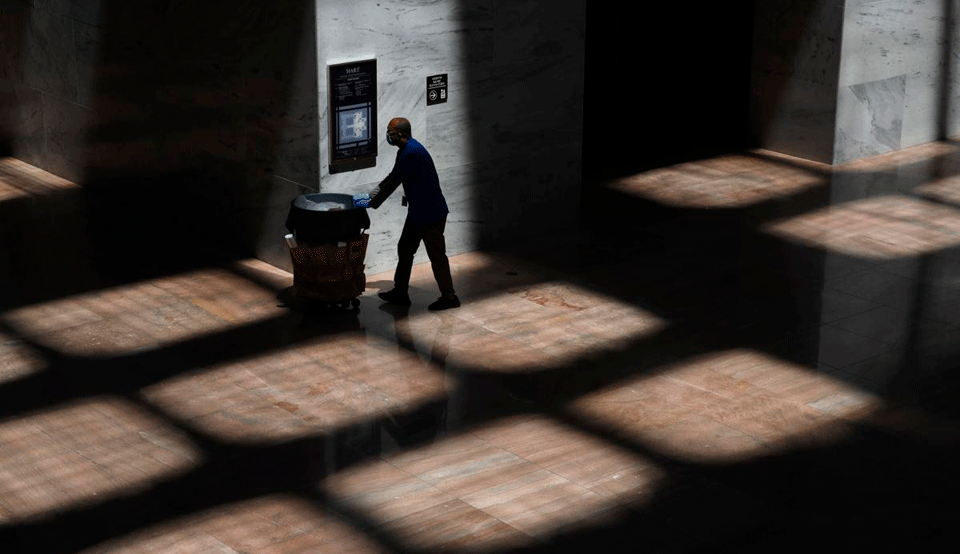
The coronavirus pandemic, it is now commonly observed, has drawn into relief, and indeed exacerbated, the various layers of inequality already fragmenting culture and society in the United States.
At the same time, when it comes to class inequality, in particular, Americans have tended to find ways to gloss over the brutal realities in the U.S. by heroicizing workers upon whom, it is at this moment impossible to deny, Americans’ lives depend. Farmworkers, grocery store workers, delivery truck drivers, in addition to doctors, nurses and other hospital workers, have now been recognized as “essential,” supposedly acknowledging their social value, while little is done to alter their remuneration, improve their working conditions, or end labor exploitation.
While these workers are deemed essential, rarely are workers solicited for their views on how our society and political economy might function more humanely and effectively.
What would a working-class cultural response to the pandemic look like? Is there a labor perspective that offers special or different insights into how we address public health issues, into how we heal our deep social ills?
If we believe Marx and Engels that “the history of all hitherto existing society is the history of class struggle,” then it stands to reason, of course, that experiences of and responses to this pandemic are inevitably bound up in these class antagonisms—that the pandemic itself is a scene of class struggle.
If we’re looking for such a model of a working-class response to pandemic, Timothy Sheard’s mystery novel One Foot in the Grave (official publication date Feb. 5, 2019) offers an eerily prescient example. The novel is the eighth installment in Sheard’s Lenny Moss mystery series, all of which are set in the hospital workplace. Sheard weaves his murder mysteries with the intricate and fascinating drama of all the labor that goes into the work of healing, from the custodial work that cleans and sanitizes the hospital, to the engineers who maintain building operations, to the foodservice workers, to the doctors and nurses and more.
The corona pandemic heightens the relevance of Sheard’s work to be sure. One Foot in the Grave takes on particular relevance as Sheard imagines an outbreak of the Zika virus in Philadelphia, challenging the hospital staff in their healing efforts in all the ways we see healthcare workers stressed in these times: dealing with lack of PPE and other equipment, facing capacity issues, working in dangerous conditions that expose them to the virus, and so forth. The novel uncannily prefigures the current pandemic conditions in society and the working conditions in hospitals we see today.
The hospital workplace is Sheard’s Conradian sea, full of drama represented in ways that challenge the dominant culture’s “degradation of labor.” Harry Braverman develops this term in his 1974 classic study Labor and Monopoly Capital, referring to two phenomena. First, the term describes the way an intensified division of labor has eroded craft and artisanal expertise by taking work and breaking it into smaller and smaller tasks, thus “de-skilling” the worker. Second, the term refers to the way this process then enables us to de-value the necessary work people do. We come to refer to such types of work as “unskilled,” justifying the low wage at which the work is remunerated and, hence, in social terms, valued and appreciated.
This degradation results in the dismissal and ignorance of the talents and expertise workers in all positions in the labor force possess and also creates damaging divisions within the labor force between erroneously defined categories of “skilled” and “unskilled,” or “professional” and “worker.” Thus the possibilities are disarmed for the cooperative leveraging of all the social and intellectual power we have at our disposal to solve problems and address our collective social needs in the service of all lives.
And it is through his intricate representations of work and workplace relations, as well as his representation of class conflict in the hospital, that the novel provides a narrative of working-class response to pandemic conditions, and of working-class solutions to larger social ills.
One Foot in the Grave presents these solutions as involving a combination of overcoming class divisions, developing solidarity and cooperation among all workers, and respecting and availing ourselves of the working-class knowledge typically dismissed within U.S. capitalist culture.
From the first page, Sheard conveys high-strung class tensions in the hospital as Catherine, a pregnant nurse, is in tears, needing her job but fearful of the potentially toxic workplace endangering her and her unborn child. She is unable to refuse work assignments or not come to work, and she has no union to advocate for the safety of her work conditions or protect her job.
The second chapter opens with Lenny Moss, James Madison Hospital’s custodian and also chief sleuth for whom Sheard names his series, complaining that the hospital executives do not supply him with enough bleach to do his job while he does work essential to providing a healthy environment for patients. Sheard describes the work to make clear the importance and value of Lenny’s job to the overall work of healing: “He ran the mop over the old, cracked marble floor in broad strokes, washing away a night’s worth of spills and stains. It wasn’t the work he had to do this morning that was annoying Lenny.… It was the boss’s unwillingness to supply him and his co-workers with bleach that had gotten under his skin.”
Then Dr. Auginello, chief of the Infectious Disease Division, checks in with Lenny while instructing his residents. He explains to them that “the most effective preventive strategy is to continually clean horizontal surfaces.” He elaborates, with particular relation to the Zika virus: “Once droplets fall onto the horizontal surfaces, we touch them with our hands and transfer them to our skin. So continuous cleaning of the environment with a strong antiseptic solution remains the most effective procedure for preventing horizontal transmission, and bleach is the most effective solution for killing virus.”
Auginello explains that the “business” interests in the hospital try to cut down on the use of bleach because patients don’t like the smell and complain, and it is important to them to secure positive patient satisfaction surveys.
The doctor and Lenny share important technical knowledge. We see the doctor valorizing custodial work, and the knowledge that informs it, and its important role in contributing to the overall task of healing patients. Throughout the novel, Auginello cooperates with other hospital workers to create the best conditions for serving patients. For example, when the hospital is running low on negative pressure rooms and HEPA filters are difficult to find, Katchi, the maintenance engineer, figures out that they can create the same environment in rooms with fans they can purchase at Home Depot, where they can also buy paint masks to make up for the shortage of standard hospital issue masks. Through these relations, Sheard challenges the degradation of labor by putting all of this technical knowledge, hermetically contained in occupations typically stratified by class, on equally important footing.
Auginello represents solidarity itself. His goal is to serve patients, and the class system presents an obstacle to his ability to fulfill his Hippocratic oath. If he operated according to the values of class society, he would likely dismiss out of hand the knowledge a janitor or maintenance engineer can contribute to optimizing medical care for patients. Solidarity and the dismissal of class distinctions are central to performing his job most effectively.
Lenny and Auginello, in fact, together represent a cross-class solidarity rooted in a reordering of values and status and in a common respect for one another, offering the cultural basis for exploding the ideological underpinnings of class society altogether.
Lenny, of course, is not only the central intelligence solving crimes novel after novel. He is also the go-to authority, in part because of his union activism, to whom other workers—doctors, nurses, staff—turn to help resolve workplace conflicts and problems.
In One Foot in the Grave, some nurses come to Lenny, a leader in the Hospital Service Workers Union, asking for help in addressing dangerous and oppressive working conditions. Lenny works with them to help them organize to become unionized.
Here we see the fault lines in solidarity, rooted in class divisions and a class value system that forwards the degradation of labor. Some of the nurses are uncomfortable, for example, joining a union with service workers. One nurse, Agnes, “was not sure she wanted to be in a union with service workers, she was a professional, they were all non-professionals.”
This division persists in the novel, posing an obstacle to worker solidarity and hence to the nurses addressing and improving working conditions. The question abiding in the novel is raised by Mimi, a nurse trying to organize the union. “She asked herself: what would it take to win them to the union? How could she break through their stubborn ideas about being ‘professionals?’ Lenny had often said, every worker is a professional, every job is a skilled job. Why couldn’t the nurses see that?”
Oh, and yeah, there is a murder to be solved, involving a former resident who tries to poison the attending physician who had him dismissed for sexually abusing a cadaver.
I am focusing minimally on this mystery not just out of aversion to plot-spoiling but because it is less consequential to the success of the novel. Sheard provides a broader social mystery to be resolved. Typically detective novels have been understood as conservative in nature, featuring plots designed not to find society guilty but to find the individual criminal guilty and restore innocence to society, validating the dominant social conceptions of law, order, and class hierarchy, thus forestalling social critique.
But the real mystery for Sheard is that of class struggle and when workers will unite. Sheard leaves this mystery unsolved, leaving the fate of the working class and status of unions to be resolved at a future time in the march of history. Yet that march is not an abstract process but rather one that people direct. This novel is an attempt to raise the consciousness of workers to direct that march toward a union movement rooted in solidarity, overcoming the cultural class biases and misguided labor aristocracies that fragment the working class.
Part of the meaning of the novel’s title, in fact, is that the labor movement has one foot in the grave. Unless it can overcome divisions within groups of workers themselves, it cannot engage in the struggle between classes.
Overcoming class differences, which can enable truly cooperative work, is the key to being able to heal our world, inside and outside the hospital.
Knowing how to address and coordinate a response to a pandemic means understanding the many layers and levels of work involved in treating illness, from the way a janitor cleans a floor or disinfects a room, to the workers who operate and maintain communication networks, to orderlies, nurses, doctors and more. That means seriously respecting all of this work—and thus overcoming the degradation of labor that so animates the culture of our political economy.
In many instances, the literary works valorized in capitalist culture participate in erasing the traces of labor. Sheard is clear in One Foot in the Grave that we must confront the facts of labor directly, and the obstacles class society presents in constraining an organization of work from optimally serving us and promoting healthy workplaces and a healthy society. Otherwise, we cannot address pandemic conditions in a humane way.
Are we surprised that as the wealth gap has widened precipitously in the U.S. over the last decade or more, the average life expectancy has actually declined? We shouldn’t be.
Timothy Sheard
One Foot in the Grave
Hardball Press, 2019
$15.00, 288 pp.
ISBN 13: 9781732808836












Comments